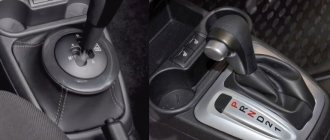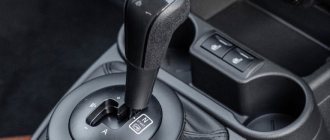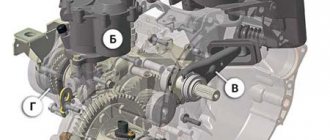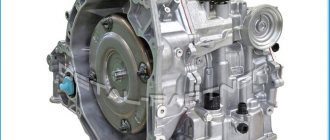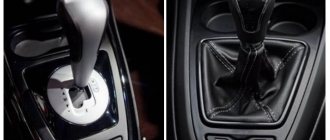Popular rumor is a scary thing. Take robotic gearboxes, for example. The amount of knowledge about them among the population is approximately the same as that of teenagers about intercourse: someone has heard something, someone knows something about how, where, and most importantly - why, but few have seen and understand what it is. actually.
Judging by forum remarks from buyers and even reviews from less experienced colleagues, few people like the VAZ AMT the first time: it doesn’t know how to do it, it doesn’t do that, it’s unlucky... How could it be otherwise if you don’t know what to eat it with?
The “robot” cannot be approached as a classic AT. It's not AT because. In essence, this is the same mechanics, only the closing and opening of the clutch discs is controlled by automation. In classic ATs, instead of a clutch, torque goes to the drive axle through a torque converter. That’s why the operation is a little smoother than that of the RT, but a considerable part of the power is lost in the torque converter fluid. This is especially true for cheap boxes of this type.
| Automatic transmission from Renault: torque converter, a bunch of gears, extra weight... |
A robot is an intermediate thing. When you want two pedals, but also save money. And not only for the buyer, but also for the manufacturer. And so it happened: the AMT box was made on the basis of the old VAZ mechanics: specialists from the German ZF attached actuators to it (the same ones that control the clutch engagement). Therefore, the work was done very quickly.
| Mechanics of the VAZ-2180, which served as the basis for the AMT. |
“Why was it needed at all?” - an erudite reader will ask. After all, the Grant and Kalina had an excellent Jatco automatic machine - Japanese, reliable, inexpensive. Yes, the car with it accelerated for about 48 years from a standstill to the first hundred, and at -28 it was forcibly turned off for safety, but it worked!
| 4-speed Jatco unit from Granta/Kalina/Datsun. |
And it's true. There are several answers. Firstly, as I already said, the robot is cheaper for the manufacturer in all respects. Structurally, it is simpler than an automatic transmission with a torque converter, and, moreover, the era of import substitution is in the yard, and the Japanese unit must be purchased assembled and in freely convertible currency. 80–90 percent of AMT components are made in Tolyatti: RT even goes along the same line of the conveyor as the donor mechanics 2180–2182. By and large, there are only imported ZF actuators, and this is a huge plus (or minus?) to the cost.
Secondly (and dealers won’t tell you this), the Granta/Kalina family has now grown with two Datsuns - on-Do and mi-Do. Who also want a version with two pedals. Therefore, at the top it was decided to separate two families: the Grants were left with the import-substituted RT, and the Datsuns were given the Jatco automatic transmission - so that these cars would have at least something Japanese, besides the nameplate. Colleagues from the Datsun head office, by the way, speak arrogantly about the robotic box and say that they did not take on them on principle: “We don’t want to sacrifice the convenience of the client...”
Now about convenience.
| The robot selector, as expected, differs from the automatic one in the designations and positions of the lever. There is “neutral”, reverse and “A” - an analogue of “D”, that is, “drive forward”. On the left is a groove for manual gear selection. |
The first point, which for some reason is still not always obvious to fellow citizens: in “neutral” the wheels are not blocked in any way - you need to tighten the handbrake. Otherwise, it’s usually like this: by analogy with “P”, they will move the selector - and they think that’s how it should be. No, robots are neutral. But! Since this is still the same mechanics at heart, then it can be left “in gear”! Before turning off the engine, you must move the selector to position “A” or “R”. Second point: Granta with RT is a city bird: if you trip on it, it won’t fly. The car doesn’t know how to crawl in a traffic jam on its own, nor can it hold itself up on an uphill climb—it’s imperative to give it gas.
Why do I speak in truisms? It turns out that not everyone knows these basics of communicating with RT. Then the insults, groans and angry comments towards the crooked developers begin. Therefore, just in case, such an educational program.
How's it going? Drives great. If you know the specifics of robots and do not require a DSG rate of fire from the simplest mechanism. Speed acceleration occurs extremely smoothly and linearly; by default, gears change at about 2,500 rpm. You can push the accelerator harder and deeper - the crankshaft will spin up to 4 and 5.5 thousand revolutions. The main thing is to learn to catch the moment of gear change.
Usually it’s because of this that they say about robotic boxes: “Well, they’re stupid!” No, it’s actually all stupid that isn’t Porsche’s PDK. But let's remain realistic. RT changes gears according to the same principle as MT: “clutch - gear change - clutch - gas”. It’s just that where the left leg works in the first and third phases in the simplest machines, mechatronics works here.
| The selector pad, by the way, is so-so: it moves back and forth. |
At Grant it is important to catch the moment of change and feel it. Fortunately, this is not at all difficult: at the moment of disengaging the clutch and changing gears, it noticeably falls on the nose - again, everything is like on a car with MT. And at this moment it is important to slightly release the accelerator. Then the gear change will happen quickly and without additional freezes, for which robots are so hated. You shouldn’t think that if you press your sneaker to the floor all the time, the car will impart acceleration to the wheels just as linearly - no, it won’t. I cranked it up to the nominal 2500 rpm, eased off the gas, and turned it on again.
Once you get used to the nature of the Granta AMT, it becomes quite pleasant to drive. The motor is elastic and responsive; in the “0 to 90 km/h” mode and even a little higher you can move tolerably. A couple of hours of communication - and you stop thinking about the fact that you have a “robot” altogether.
Gear changes are quite smooth. Here it would be appropriate to recall the “Auris” of the mid-2000s and the “Meriva” of the same times: their gear changes, even with the trick described above, were accompanied by spasms and convulsions. The “Grant” robot switches more smoothly and delicately. And this is not just my opinion: my partner, who took a ride in the Grant after his Opel Zafira with EasyTronic, literally said the following.
Nikolay Kovalevsky, photographer:
— On “Grant” it’s a song, not a robot. I have never seen such soft pickups and shifts in my “legendary” German car. Let's see how it performs in terms of reliability.
He has a passion for higher gears: even in a city with a torn cycle “Go/stop - go/stop” he strives to quickly escape to the top, fifth, step. The manual mode is stupid: it doesn’t want to hold the selected gear for as long as you need. Apparently, it’s foolproof, in case someone forgets to switch altogether.
But the “brains” of the box react perfectly to the load and environmental conditions: feeling that it’s already too difficult to climb the second hill, it switches to a lower one. And at the same moment in which I would have done it myself.
But the most important thing is not even how the box switches. And not what a good logic it has for changing gears up and down. And the way it sounds. More precisely, he is silent. I have already gotten used to the fact that Granta and Kalina are a constant howl, squealing, mournful groans of mechanics and the blood-curdling grinding of gears when releasing the gas. This is not the case here. It would seem that the mechanics are the same, but remove the cables and the howling will stop.
The Grantovskaya RT is combined only with a powerful engine of 106 horsepower. It’s not entirely clear, though, why? The tax rate for such a motor appears, but these extra 6 forces are, in fact, of no use. A combination with an 82-horsepower 8-valve engine would be more pleasant in all respects in the era of bargain-basement hydrocarbon prices. Probably, this option would have to be configured, but on the Priora it has already been thoroughly tested in a year - there is no need to test anything additional.
The engine is playful, even taking into account the robotic specifics. The certified acceleration is three tenths faster than that of the 82-horsepower Granta with manual transmission. It feels like it is. Yes, 12.3 sec. — it’s still like jumping on one leg to the moon, but Granta has never been able to do it any other way. At least it didn't get worse here.
On paper, the robot, in addition to the initial cost, has another undeniable advantage - efficiency, which is better than versions with AT and no worse than versions with MT. I willingly believe it. Both Kalina and Granta with an untested engine have never shown me less than 12 l/100 km. Here in those modes and along almost the same routes - 10.5 liters. A whopping 14% less! The press release, however, promised a 30% difference from the AT, but 1.5 liters per hundred is not bad. The passport requires gasoline of at least 95, we decided not to be pretentious and refuel with the “people's” 92. No worse.
The box is not the only thing that has stopped making sounds. Boo Andersson wasn’t lying to me when he said that they were making platform changes all over the world day and night. They bring it in! The 2015 Granta is quieter than it was last year: this applies to both the arches and the echoes of the incoming air, the interior produces noticeably less creaks from all sides - even the clicks of the relay do not hurt the ear. There is still work to be done. But I believe in “platform changes”.
| The immodest charm of the bourgeoisie: parking sensors, two pedals, color screen, on-board computer, air conditioning! You can already cry tears of import-substituting happiness. This is no longer a shame. |
It’s a pity, the fundamental problems of “Granta” cannot be solved simply - that’s how it’s structured. For example, the brakes are still too tight. Oleg Grunenkov, director of the Granta project, promised a new brake booster last fall, but... I still recommend starting to brake in advance and pumping up your leg muscles - the effort on the pedals is bodybuilding. Well, there’s no escape from the tightness. “behind me” (180 cm exactly) I sit down with a reserve. But if the driver is above 185, then only a person who has problems with his legs will be comfortable behind him. For example, if they are not there.
Should you look towards Granta AMT? Yes, definitely. Keeping the described features in mind. Which are actually easier to get used to than Internet experts promise in comments and forums. The surcharge is indeed conditional: the Granta sedan in the luxury version costs 468,300 rubles . The same “luxury” 106 horsepower, but with AMT - 474,600 rubles . And it all starts at 421,300 rubles .
And it's still the cheapest two-pedal offering on the market. Moreover, Granta with Jatco at the start of sales cost 78,200 than a car with MT. Here, even with the luxury version with a junior engine of 98 horsepower, the difference will be no more than 13,000 . Excellent fruits of import substitution, as I see it.
What gearboxes did it come with?
The Lada Granta passenger car has been in mass production since March 2011; this model replaced the popular Samara series.
Initially, the car was equipped only with a VAZ-2180 five-speed manual transmission; later, automatic and robotic gearboxes were installed on the car.
The cable manual gearbox Lada Granta with index 2181 has been produced since October 2012; it was later modernized, since car owners had many quality complaints about it.
Each type of transmission installed on a Togliatti-made car has its own characteristic differences and weaknesses, the so-called “diseases”.
Manual transmission Lada Granta
The manual transmission installed on the Granta has a long history; in fact, it is the same 5-speed. gearbox, like the VAZ-2108, but repeatedly subject to serious modernization.
From the beginning of Granta's production, the car was equipped with a model 2180 gearbox, with a shift rod, with the gear selection mechanism located at the bottom (inside the body), the same transmission was installed on the first generation Lada Kalina.
A modernized gearbox with index 2181 appeared in 2012, and in the new transmission:
- The gear shift rod was replaced with two cables;
- the speed selection mechanism was moved upward, it began to be located outside the housing, not in oil, as it was before;
- in 1st-2nd gear a multi-cone synchronizer appeared;
- The clutch housing has been changed; only 2.2 liters of transmission oil are now poured into the box itself, and not 3.3 liters as before.
The use of cables instead of a rod reduced the level of vibration in the body, and in general, speeds began to be switched more clearly, without “searching” for the desired gear.
But this transmission had one characteristic problem - the 2181 gearbox of the first editions emitted a noticeable howl when the car was moving.
There were a lot of complaints from car owners, so AvtoVAZ decided to refine the unit, improving the technology for processing gears and shafts, and in the summer of 2014, Granta with a quieter manual transmission began to roll off the car plant’s assembly line.
Error codes Lada Granta FL
Each error is assigned its own unique code. It consists of an alphabetic and numerical designation. The decryption begins with identifying the system that failed:
- P – damage to sensors or electrical wiring;
- C – failure in the chassis components;
- B – internal power supply of the car;
- U – desynchronization of several circuits.
The following are the standard designations: 0 – OBD2 connection module is faulty, 1,2 – department code (factory setting), 3 – electrical wiring malfunction.
Then the serial number of the electrical circuit in which the violation occurred is indicated:
– “0” – exhaust system;
– “1” – air supply system;
– “2” – fuel line, injectors;
– “4” – control and measuring equipment;
– “5” – auxiliary systems;
– “7”, “8” – gearbox and chassis elements.
The two-digit number that is triggered at the end of each code indicates the specific location that is malfunctioning.
| Error code | Decoding |
| 030-032 | Oxygen sensor: loss of communication, short circuit, failure |
| 036-038 | Second oxygen sensor: same faults |
| 101-103 | Malfunction of the mass air flow sensor |
| 107-108 | Low pressure in the inlet pipe |
| 112, 113 | Low/high air temperature in the inlet pipe |
| 115-118 | False readings from the coolant temperature sensor |
| 171/172 | Supersaturated fuel mixture |
| 200 | Failure of the fuel injector control module |
| 201-204 | Failure of electrical wiring of injector of cylinders 1-4 |
| 217 | Motor overheating, incorrect sensor readings |
| 300 | Misfire, unstable ignition |
| 301-304 | Unstable ignition in cylinders 1,2,3,4 |
| 325 | Open circuit of the knock sensor |
| 335-338 | Damage to the crankshaft position sensor wiring |
| 351-354 | Malfunction of ignition coils of cylinders 1,2,3,4 respectively |
| 363 | Air catalyst malfunction |
| 422 | Air catalyst clogged |
| 441 | Canister valve malfunction, loss of electrical circuit |
| 480/481 | Fan control relay malfunction, short circuit |
| 485 | Main engine cooling fan failure |
| 500-503 | Car speedometer is faulty |
| 504 | Malfunction of automatic brake pedal |
| 505-507 | Idle air control malfunction |
| 560 | Battery charging failure |
| 562/563 | Over/under voltage on-board network |
| 606 | Damage to the ADC module |
| 607 | Incorrect information in the detonation channel |
| 615-617 | Starter relay wiring problems |
| 627-629 | Faulty electric fuel pump relay, no connection to the coil |
| 642/643 | No connection with power sensors |
| 645/647 | A/C clutch malfunction |
| 123/124 | Insufficient air in the fuel mixture |
| 136/137 | Insufficient amount of fuel in the mixture |
| 171/172 | Potentiometer fault |
| 335 | Throttle valve faulty/stuck |
| 336 | Troubleshooting throttle sensors |
| 385 | Engine Load Limit |
| 388 | Accelerator and throttle position mismatch |
| 389 | Mismatch between crankshaft and throttle position |
| 558 | Broken throttle spring |
| 602 | Momentary loss of contact with the battery |
Automatic transmission
“Automatic” was installed on the car of the Togliatti Automobile Plant from July 2012 to March 2015 - this is 4 speed. Automatic transmission from Japanese manufacturer Jatco.
Grant's four-speed automatic transmission - model JF414E, classic type, with a torque converter; similar units are equipped in Nissan, Mitsubishi, and Suzuki passenger cars.
This type of transmission on Granta is paired only with the 98-horsepower VAZ-21126 power unit.
The gearbox is highly reliable; with careful operation and timely maintenance, it can run up to 200 thousand km.
It is necessary to replace the transmission fluid every 60 thousand km; the manufacturer recommends filling with Nissan branded ATF EJ-1 or Matic-S oil.
Automatic transmission problems.
The quality of the Lada Granta automatic transmission does not cause any major complaints; if the transmission requires repair, it is mainly due to the fault of the driver:
- as a result of slipping, the clutches burn out;
- after overheating, gaskets and seals begin to leak;
- When you hit an obstacle, the automatic transmission pan breaks through, and then a thorough repair is definitely required.
Car owners have more complaints about the performance characteristics of an automatic transmission - increased fuel consumption, sluggish acceleration of the car, jerking during gear changes during dynamic driving.
Typical breakdowns: elimination methods
Most often, motorists have to deal with frequently occurring characteristic malfunctions.
The car does not move forward. Moreover, engaging reverse gear does not cause problems. The cause may be a broken friction disc or a ruptured piston cup. Perhaps the o-rings are broken or the valve that regulates the gear shift is simply jammed.
To cope with the defect, it is necessary to replace and install other clutches. Replace all seals and install other O-rings. In addition, the valve needs to be cleaned.
If the Lada Granta is not able to move backwards, there is no third gear, it means that the clutch regulating the forward movement has failed, or the cuff attached to the piston that turns on the forward movement has broken. In addition, if severe wear appears, then the sealing rings, the front clutch have been destroyed, or the splined mechanism holding the sun gear has simply been cut off.
The repair consists of installing other friction discs, installing new cuffs, and installing new sealing rings. All defective parts must be replaced.
It happens that it is impossible to engage reverse gear. This means that the brake band has completely worn out or the cuff has broken. The failure of the piston rod must also be taken into account.
The repair consists of replacing the brake band, cuff and the rod itself.
It happens that there is no movement. This can cause the following damage:
- the hydraulic transformer has failed;
- oil pump failed;
- insufficient oil volume;
- The filter mesh is clogged.
- friction discs are broken;
- brake band defect;
- the cuff is torn;
- O-rings are broken;
- The valve responsible for the first speed is jammed.
In this case, you need to install a new hydraulic transformer. If the problem is with the oil pump, you need to remove the bolts securing the GT together with the flywheel. Between them it is necessary to install gaskets 2 mm thick. Tighten the bolts tightly.
You need to start the car, add oil so that the volume corresponds to the upper limit, and flare the filter. Thoroughly wash the mesh; if it becomes unusable, install another filter.
You can dismantle the brake band and install a new one. Install other discs on the brake clutch. Put on good cuffs. Install new sealing rings and clean the valve after disassembly.
Sometimes the car is stationary, but when the gear is engaged, a strong push is felt. The car slips and continues to stand. This means that the hydraulic transformer has broken down or the automatic transmission oil volume is too low. The oil filter may be clogged. You need to install a new torque converter and simply add transmission oil to the required level. And, of course, clean the filter.
Robotic gearbox
The robotic gearbox replaced the 4-speed Jatco automatic transmission; manual transmission has been installed on the Grant since the beginning of spring 2015.
The basis of the mechanical part of the new AMT 2182 was the 2180 gearbox; instead of cables, as well as the standard pedal and clutch unit for “mechanics,” an electromechanical gearbox drive (mechatronics) from the German company ZF was installed here.
The robotic gearbox is only paired with a VAZ-21127 106 hp engine. s., the most powerful power unit installed on the Lada Granta.
The manual transmission can operate not only in automatic, but also in manual mode; there are a total of five gears in the box.
A car with AMT 2182 has become more economical than with an automatic transmission, the dynamics have also improved, and gasoline consumption has decreased.
Typical problems of a robotic gearbox.
The robotic gearbox is based on the 2180 transmission, so it does not have such a strong hum as the 2181 manual transmission.
However, in first and second gears, slight howls are observed, although after running in a new car, the noise may disappear.
Grant's gearbox may behave inappropriately - when driving in first gear and sharply pressing the accelerator pedal, second speed does not always engage, and a “slip” occurs.
A characteristic disadvantage of a manual transmission is jerks and jolts when changing gears; if the movement is dynamic, this unpleasant phenomenon is not observed during quiet driving.
But you can use the manual mode, and then the manual transmission practically becomes a “mechanics”.
Design and operating principle of AMT
In general terms, AMT is a conventional manual transmission in which two special actuators (servo drives) are responsible for clutch operation and gear shifting. Each actuator installed on the gearbox is an electric motor with a gearbox and an actuator. The entire system is controlled by an electronic unit that selects and engages the required gear.
New LADA Granta on robot
The electronic unit takes into account the vehicle speed and engine operating mode, as well as information received from systems that monitor traffic safety (ABS, BAS, EBD, etc.). Evaluating and analyzing all the information received, the electronics unit issues a command to change gear.
After receiving the corresponding signal, the clutch is depressed using one servo drive, and the second one at this time engages the desired gear. Then the first servo smoothly releases the clutch.
When operating in Tiptronic mode (manual control), the driver independently moves the selector knob towards higher or lower gear and thereby issues the AMT command.
Note: when using a robot, there is no need for a clutch pedal.
Gearbox selection
All types of gearboxes on the Lada have their advantages and disadvantages, but even the domestically assembled Grant gearboxes do not cause very big problems for car owners.
If we do not take into account the slight noise of the mechanical part of the transmission, then we can say that the “robot” and “mechanics” are quite reliable, without pronounced characteristic “diseases”.
For those who like a leisurely drive and comfortable driving, an automatic transmission is best; there is only one drawback - increased gas consumption.
Although the manual transmission whines, the noise does not particularly affect its service life; during normal operation, it can travel about two hundred thousand kilometers without problems.
The electronics in the robotic box sometimes malfunction, and you need to get used to the specifics of driving a car with AMT.
Which transmission to choose for the Lada Granta is a personal matter for each motorist; a lot here depends on the preferences of the driver himself.
Common problems
If it is not possible to brake the engine when the second speed is engaged, it means that the brake band is not working and the sealing collar is broken. Maybe the modulating valve is stuck.
In such cases, it is simply necessary to install a good brake band and other piston seals. Next, clean the valve system. That's all.
When gears are changed, clutch slippage occurs. This means that the filter mesh is clogged or the oil volume is insufficient.
In this case, you need to install a new filter and top up the oil. The filled oil must exceed the upper level. You can also install a new coupling.
There is a grinding noise where the differential is located. The main differential driven gear is not functioning and the drive gear teeth are broken. Perhaps there was increased wear of the bearings and the clearance on the axle increased significantly, causing differential play to appear.
Here you just need to replace the differential and install new bearings.
If reverse gear does not engage and there are no second and third speeds, it means that all the drum splines on the sun gear have been cut off. You just need to install a new drum.
